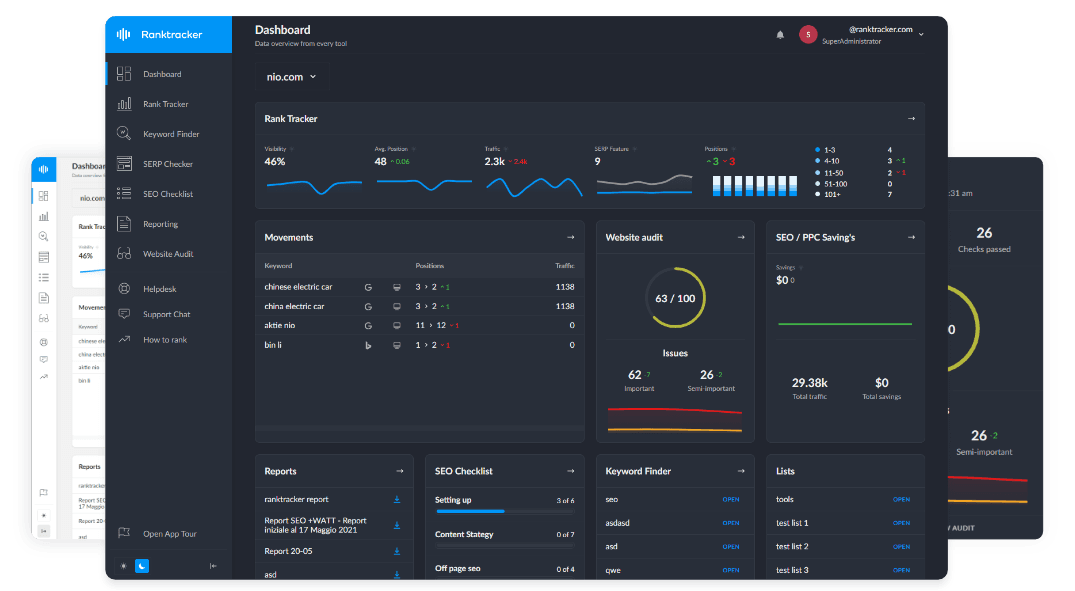Intro
In the digital age, museums must compete not only for foot traffic but for online visibility. Whether people search for “art museums near me,” “science exhibitions in [city],” or “virtual museum tours,” your institution needs to appear at the top.
A structured SEO strategy—supported by Ranktracker’s comprehensive tools—ensures your museum ranks higher, attracts more visitors, and becomes a leading cultural destination online and offline.
Why SEO is Critical for Museums
High search visibility drives attendance, boosts cultural influence, and increases revenue from ticket sales, memberships, and donations. Without SEO, your exhibitions, events, and educational resources remain hidden from potential visitors.
Key benefits of SEO for museums:
-
Rank for high-intent searches like “best museums in [city]” or “interactive science museum”
-
Increase foot traffic, virtual tour participation, and event attendance
-
Attract tourists, families, students, and cultural enthusiasts
-
Drive memberships, donations, and brand partnerships
-
Enhance reputation as a leading cultural, historical, or educational institution
Ranktracker’s Rank Tracker monitors your keyword performance and helps you outperform competing museums and cultural attractions.
Keyword Research: Capture Visitors, Tourists, and Culture Seekers
Effective keyword research positions your museum for high-traffic, visitor-focused searches.
Use Ranktracker’s Keyword Finder to identify SEO opportunities such as:
-
art museum [city]
-
science museum near me
-
historical exhibitions [region]
-
virtual museum tours
-
free museum days [city]
-
interactive museum for kids
-
famous museum collections
-
best cultural attractions in [city]
-
educational museum resources
-
museum events this weekend
Target a combination of local, educational, event-specific, and virtual experience keywords to attract both in-person and online audiences.
Ranktracker’s Keyword Finder provides search volume, competition analysis, and trend insights to guide your strategy.
On-Page SEO: Convert Searches into Visitors and Cultural Engagement
Optimized website pages, event listings, and virtual exhibits improve rankings and encourage visitors to engage.
Essential on-page SEO for museums:
-
Compelling, keyword-rich meta titles and descriptions for exhibitions, events, and visitor resources (test with Ranktracker’s SERP Simulator)
-
Clear H1 headings like “Explore the Best Art Museum in [City]” or “Join Our Family-Friendly Science Exhibits”
-
Dedicated pages for ticket sales, opening hours, exhibitions, membership, and virtual experiences
-
Strong CTAs: “Buy Tickets,” “Plan Your Visit,” “Take a Virtual Tour,” “Become a Member”
-
Use schema markup for events, location, opening hours, reviews, and online exhibits
Ranktracker’s Web Audit identifies technical gaps, missing metadata, and weak content that limit your museum’s online visibility.
Content Marketing: Educate, Inspire, and Build Cultural Authority
Content marketing turns your museum into a trusted cultural resource that attracts search traffic and builds long-term authority.
The All-in-One Platform for Effective SEO
Behind every successful business is a strong SEO campaign. But with countless optimization tools and techniques out there to choose from, it can be hard to know where to start. Well, fear no more, cause I've got just the thing to help. Presenting the Ranktracker all-in-one platform for effective SEO
We have finally opened registration to Ranktracker absolutely free!
Create a free accountOr Sign in using your credentials
Proven museum content strategies:
-
Create content clusters like “Top Museums in [City],” “Behind the Scenes of [Exhibition],” or “Museum Learning Resources for Schools”
-
Publish educational articles, exhibition previews, and historical insights
-
Share multimedia content—virtual tours, curator interviews, or artifact showcases
-
Provide downloadable resources for teachers, families, and tourists
-
Cover topics like “Why Visit Museums,” “Art Restoration Processes,” or “Science Behind the Exhibits”
Ranktracker’s AI Article Writer helps produce optimized, engaging content to drive traffic and position your museum as a cultural leader.
Local SEO: Attract Visitors in Your City and Region
Local SEO ensures your museum appears in geographic searches and attracts both residents and tourists.
Local SEO for museums includes:
-
Location-specific pages: “Visit [Museum Name] in [City]” or “Plan Your Trip to [Museum]”
-
Optimize for keywords like “museums near me” and “[City] cultural attractions”
-
Maintain accurate NAP details across Google, directories, and your website
-
List your museum on Google Maps, cultural directories, and tourism platforms
-
Translate key content for multilingual audiences, especially in tourist hotspots
Ranktracker’s SERP Checker helps track local rankings and reveals new opportunities to capture visitor search traffic.
Backlink Building: Boost Authority and Increase Cultural Reach
Backlinks from trusted cultural, educational, and travel platforms enhance your domain authority and visibility.
Effective backlink tactics for museums:
-
Collaborate with local tourism boards, cultural blogs, and travel websites
-
Earn links through media coverage, partnerships, and event listings
-
Contribute guest articles to educational platforms and cultural publications
-
Promote online exhibits or resources to schools and universities for backlinks
-
Attract links via virtual events, research initiatives, and award recognitions
Ranktracker’s Backlink Checker and Backlink Monitor help you track and expand your museum’s authority-building backlink profile.
Visual SEO: Showcase Exhibits, Virtual Tours, and Cultural Experiences
Optimized images and videos enhance engagement, support SEO, and inspire potential visitors.
Visual SEO best practices for museums:
-
Descriptive filenames like “art-exhibition-gallery-[museum-name].jpg” or “interactive-science-exhibit-tour.mp4”
-
Keyword-optimized alt text for exhibits, galleries, and visitor experiences
-
Include high-quality images of exhibitions, events, and collections
-
Offer video previews of exhibitions or highlights of virtual tours
-
Compress visuals for fast-loading, mobile-optimized user experiences
Ranktracker’s Web Audit identifies image optimization issues and ensures your visual content strengthens search rankings.
Technical SEO: Deliver a Fast, Accessible, and Visitor-Friendly Experience
Technical SEO ensures your museum’s website offers a seamless experience that builds trust and improves rankings.
Technical SEO essentials:
-
Secure HTTPS across all pages, especially for ticket sales and membership sign-ups
-
Optimize website speed and mobile usability for visitors on-the-go
-
Clear site structure with easy navigation to exhibitions, ticketing, and visitor info
-
Implement structured data for events, opening hours, virtual tours, and reviews
-
Use Ranktracker’s Web Audit to maintain technical health and performance
Reputation & Reviews: Build Trust and Attract More Visitors
Online reviews and positive mentions influence visitor decisions and search visibility.
Reputation-building for museums includes:
-
Showcase verified reviews on Google, TripAdvisor, and cultural directories
-
Encourage visitor testimonials and photo submissions
-
Highlight media features, awards, and partnerships
-
Engage with feedback and address visitor concerns publicly
-
Build community presence through events, education, and partnerships
Ranktracker’s Reputation Management tools help monitor reviews, manage your reputation, and boost visitor trust.
Analytics & SEO Performance Tracking
Consistent tracking ensures your SEO strategy drives traffic, engagement, and revenue growth.
Key metrics for museums:
-
Keyword rankings for exhibitions, museum type, and local searches
-
Website traffic, ticket sales, and event registrations
-
Content engagement and visitor resource downloads
-
Backlink profile growth and domain authority improvements
-
Technical health, page speed, and mobile usability
Ranktracker’s unified dashboard provides real-time SEO performance data to refine your museum marketing strategy.
Advanced SEO for Museums
For cultural institutions aiming to lead in digital visibility:
-
Optimize for voice search: “Museums near me,” “Best science museum for kids”
-
Build extensive content clusters on exhibitions, events, and education
-
Target long-tail keywords for niche audiences (art lovers, families, educators)
-
Regularly update exhibitions, event listings, and visitor resources
-
Use Ranktracker’s SEO Checklist to ensure complete technical and content optimization
Common Museum SEO Mistakes to Avoid
-
Ignoring local SEO and tourist-specific search terms
-
Failing to optimize for mobile users and fast-loading pages
-
Weak content or outdated exhibition information
-
No backlinks from cultural, travel, or educational sources
-
Missing trust signals—reviews, testimonials, or partnerships
-
Not tracking SEO performance and visitor engagement
Museum SEO Checklist
- Keyword-optimized pages for exhibitions, events, and visitor resources
- High-quality content clusters for education, culture, and tourism
- Local SEO with accurate listings and location-specific pages
- Strong backlink profile from trusted cultural and travel platforms
- Optimized visuals and technical performance for mobile-friendly experiences
- Positive reviews, media features, and trust-building resources
- Ongoing SEO tracking with Ranktracker’s all-in-one platform
Conclusion
In today’s competitive digital landscape, museums must stand out online to attract visitors, inspire cultural engagement, and drive revenue. With Ranktracker’s comprehensive SEO platform, your museum can improve visibility, dominate search rankings, and become a leading cultural destination both locally and globally.
Start improving your museum’s SEO today with Ranktracker—and bring more visitors to your exhibitions, events, and educational experiences.

